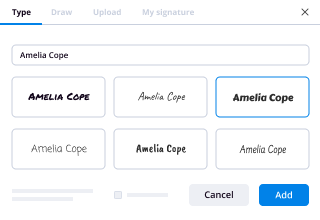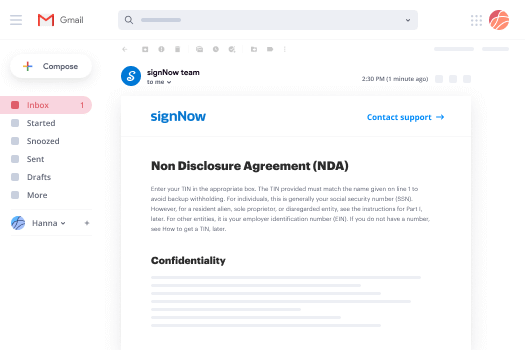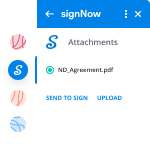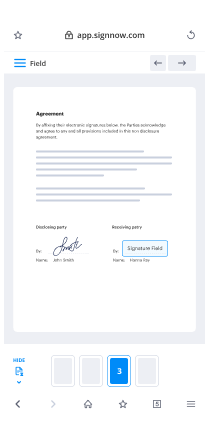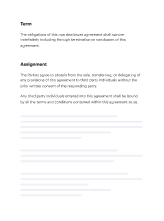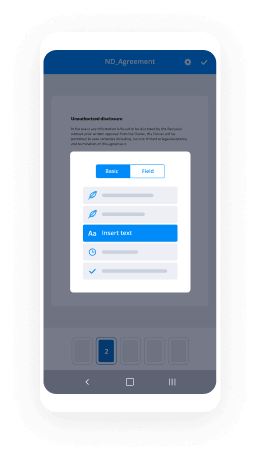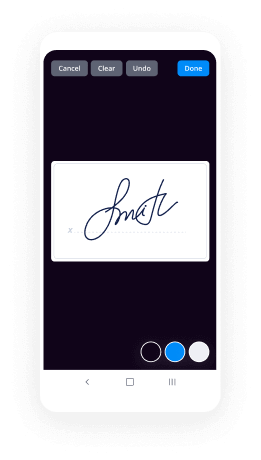How Do I Install Sign in CRM
Contact Sales
Make the most out of your eSignature workflows with airSlate SignNow
Extensive suite of eSignature tools
Robust integration and API capabilities
Advanced security and compliance
Various collaboration tools
Enjoyable and stress-free signing experience
Extensive support
Keep your eSignature workflows on track
Our user reviews speak for themselves






How to set up an account on airSlate SignNow
Establishing an account on airSlate SignNow is your initial move towards optimizing document management and e-signature workflows for your enterprise. This robust tool allows organizations to develop, distribute, and sign documents effectively, boosting efficiency while maintaining compliance. Whether you are a small enterprise or part of a larger entity, airSlate SignNow provides a variety of functions customized to suit your requirements.
Instructions to set up an account on airSlate SignNow
- Launch your web browser and go to the airSlate SignNow website.
- Create a new account by registering for a complimentary trial, or log into your existing account.
- Choose the document you want to upload for signing, or create a new one.
- For future convenience, consider transforming your document into a reusable template.
- Adjust your document as needed, adding fillable fields or relevant information.
- Insert your signature and incorporate signature fields for the recipients.
- Click 'Continue' to set up the eSignature invitation and send it out.
By adhering to these instructions, you can effortlessly establish your account on airSlate SignNow and begin reaping its advantages. With an extensive feature set and clear pricing, it’s crafted to provide outstanding ROI while being accessible for businesses of all scales.
Don't delay any further to improve your document workflow. Start your complimentary trial today and discover the effectiveness of airSlate SignNow!
How it works
Rate sign add
-
Best ROI. Our customers achieve an average 7x ROI within the first six months.
-
Scales with your use cases. From SMBs to mid-market, airSlate SignNow delivers results for businesses of all sizes.
-
Intuitive UI and API. Sign and send documents from your apps in minutes.
A smarter way to work: —how to industry sign banking integrate
FAQs
-
How do I add an account in airSlate SignNow?
To add an account in airSlate SignNow, simply visit the SignNow website and click on the 'Sign Up' button. Follow the prompts to enter your email and create a password. Once your account is set up, you can start using all the features immediately.
-
What are the pricing options for adding an account?
airSlate SignNow offers various pricing plans to accommodate different business needs. When you add an account, you can choose from options like the Business plan or the Enterprise plan, each providing unique features and benefits. Check our pricing page for detailed information on what each plan includes.
-
Can I add multiple accounts under one email address?
No, you cannot add multiple accounts under one email address in airSlate SignNow. Each account requires a unique email address for registration. However, you can manage multiple accounts by using different email addresses or creating a team account to collaborate efficiently.
-
What features are included when I add an account?
When you add an account with airSlate SignNow, you gain access to a suite of powerful features, including document eSigning, templates, and advanced security options. Additionally, you can integrate with various third-party applications to enhance your workflow.
-
Is it easy to add an account for my entire team?
Yes, adding an account for your entire team is straightforward with airSlate SignNow. You can create a team account that allows multiple users to collaborate on documents, manage permissions, and access shared templates. This enhances efficiency and streamlines your document management process.
-
What integrations are available when I add an account?
When you add an account with airSlate SignNow, you can integrate it with several popular applications like Salesforce, Google Drive, and Dropbox. These integrations allow for seamless document management and enhance your productivity by connecting all your essential tools in one platform.
-
What are the benefits of using airSlate SignNow when I add an account?
Adding an account with airSlate SignNow provides numerous benefits, such as time savings, improved document accuracy, and enhanced security for your files. The platform's user-friendly interface ensures that you can send and eSign documents quickly, making it ideal for businesses of all sizes.
-
How do you start a company? What is the minimal set of administrative hoops that one needs to (and/or should) go through to turn
Every step ??? Okay - Here is every small step in the chronological order Hope it helps - The Sure Steps - 1. Figure out what change you want to make in the world. Nothing else matters and you should not even be beginning a company until you know the change you are passionate about making, personally and professionally. 2. Begin researching the industry and your competitors. 3. Determine how to create your product. 4. Talk to potential customers and users for feedback. 5. Come up with a name for your company and product. 6. Build your pitch deck. This is particularly important if you need to raise funding. 7. Create pro forma financial projections. These should show the next 3-5 years, and include a pro forma income statement and a pro forma cash flow statement and balance sheet. 8. Determine how much capital is necessary to get to cash flow positive by calculating your cash flow breakeven point. 9. Get feedback on the pitch deck from your mentors, advisors, friends, and family. 10. Find a cofounder, if needed, whose skills complement your own and can help you achieve more. 11. Select a quality corporate law firm in your area when you are ready to incorporate and get some legal advice. 12. Incorporate and obtain an Employer Identification Number from the IRS 13. Open your company bank account. 14. Talk to your attorney about whether you should make an 83b election. These are often important in signNowly reducing your taxes in a very legal way by paying your taxes upfront when you start a company. 15. Build a basic product prototype or Minimum Viable Product(MVP), a term coined by Eric Ries which has become very common in startup circles over the past couple of years. 16. Create employee agreements for everyone 17. Create confidentiality agreements for everyone, both employees and contractors, from the beginning. 18. Hold your initial Board of Directors meeting, which could just be with yourself or maybe two board members that you appoint. 19. Create your Restricted Stock Unit (RSU) plan and/or your stock options plan that enable you to provide equity ownership and incentives to your employees to gain ownership in the company over time. Often you want to vest those options over a period of four to five years. 20. Issue your stock certificates to yourself and to your initial founding team. 21. Fund your bank account with the initial capital contribution either coming from yourself, friends or family, or peer-to-peer lending organizations like Fundable or Kickstarter. 22. Determine whether you need outside capital to start. 23. Raise any initial capital you need. 24. Get a company debit card and credit card and apply for a corporate credit line if you need to. 25. Set up your accounting software and begin putting in your chart of accounts. 26. Select your payroll provider so you can actually pay your employees. 27. Consider trademarking the names of your company and product. This is something to discuss with your lawyer. 28. Design your logo. 29. Create some business cards. 30. Find office space to work out of (if you need to.) 31. Furnish your office. 32. Purchase any software or hardware you need. 33. Get Internet access set up, which is obviously critical in a tech company. 34. Obtain a Universal Product Code (UPC) if your product is going to be sold in stores. 35. Design any labeling and packaging if needed. 36. Finish your initial alpha/prototype product and bring it to market regardless of whether it’s a tangible product or an intangible software good. 37. Get initial user and customer feedback. 38. Order your initial inventory, if needed. 39. Register your domain name 40. Design your company website. 41. Install a tracking tool like Google Analytics on your website 42. Add a shopping cart if you choose to pursue e-commerce. 43. Get a merchant account if you want to accept credit cards. 44. Sign up for an email list tool like iContact or MailChimp. 45. Optimize your website for the search engines by adding content or adding a blog and getting other websites to link to you. 46. Install a Customer Relations Management (CRM) system—a tool that can track your customer base and the interactions you have with your customers and users. 47. Hire your initial staff to be able to begin your operations. 48. Create your company values and mission statement 49. Announce your product launch to the local media. 50. Hold your launch event and start selling. Those are the first 50 steps to being ready to sell your product. The next 50 steps are all about once you start selling, how you can build your business to your first million dollars in sales. 51. Hire a team to fulfill your orders and provide customer service. 52. Start an affiliate program or distributor program, which enables you to get other people to sell your product for you for a percentage of the sale. 53. Recruit affiliates and distributors. 54. Set up an ad tracking system so you can track your advertising and the results, conversion rates, and cost per lead. 55. Try different online advertising techniques like cost-per-click advertising with a small test budget. 56. Get some results for that advertising. 57. Optimize and scale it as needed. 58. Determine the cost of acquisition per lead for each channel. 59. Determine the conversion rate for each channel. Then you can combine those to determine the customer acquisition cost by channel. 60. Calculate the lifetime value (LTV) of a customer. Once you know that, you’ll know how much you can spend to acquire a new customer, which is critical to being able to scale your business’s marketing scientifically. If you can combine great storytelling with scientific marketing and trackable channels, you can rapidly grow your sales. 61. Test your marketing and advertising with a bigger budget now that you know your LTV. 62. Test social advertising and display ads, and calculate the return on investment. 63. Scale your advertising up until the marginal cost of customer acquisition is equal to the marginal return from that customer acquired. 64. Optimize your advertising to bring down your customer acquisition cost. 65. Collect testimonials and use cases from those customers and perhaps even build a few PDF case studies. 66. Create social word of mouth for your product, using a tool like HootSuite to manage what’s being said in the media about you, your product, and your brand. 67. Create a YouTube video promoting your product. 68. Attend an industry trade show or conference. 69. Consider selling your product in bulk at wholesale to get more sales and initial brand awareness. 70. Bring on a bookkeeper to automate your accounting system so you can stop doing it yourself now that you may have started to have some real revenues. 71. Create an employee directory, once you get beyond a handful of employees. 72. Begin reviewing your profit and loss (or your income statement) and your balance sheet monthly. 73. Compare your initial forecast with actual results. Take the budget that you created before you began and compare that initial pro forma forecast with your actual profit and loss results. Compare the deltas and talk about them as you create your next iteration of your budget. Eventually you’ll begin creating budgets annually and locking in those budgets and calling those the plan, and then comparing actual results on a monthly basis against your annual board-approved plan. 74. Hire your first salesperson. 75. Create a sales compensation plan that enables you to pay someone either on a percentage of sales basis or based on the units they deliver by converting customers or up-selling customers. 76. Set up a company healthcare program and other benefits for your employees. 77. Establish your vacation policy. 78. Test offline advertising carefully. You’ll want to put some toes in the water around offline advertising like direct mail or maybe local radio, and begin to test and get results and determine if it works for you. It takes a lot of testing to make your offline advertising scale. 79. Create an online wiki or intranet for your company where you can keep track of your processes. 80. Create a digital company handbook that can be edited and improved by your employees, like a Wikipedia article. 81. Open up a credit line with your bank. The best time to go after funding is when you don’t need it. If things are going well, go ahead and open that credit line. 82. Create an offsite work policy. Some of your employees may want to work remotely. Generally, as long as they’re getting their work done and are able to show up to the meetings you do have, which should be pretty minimal initially, you should be able to enable them to work offsite a couple days a week. 83. Once you can show that $1 in means $4 in revenue, raise capital.Until then, bootstrap as much as you can. Only raise your initial round of capital once you have a mathematical model for scalability, then go out and raise a true series A round of funding if you choose. 84. Create a list of firms from which to raise initial growth funding. 85. Update your pitch deck with the new data, new mentors, and new team members. 86. Build relationships with industry bloggers and different people in the media. 87. Seek product reviews. 88. Hire an Executive Assistant (EA) or an office manager to manage your schedule and the business’s day-to-day tasks. 89. Hold your first company retreat. 90. Take customer feedback and improve your product. You will want to create a product management process to incorporate customer feedback on an ongoing basis. Use this process to take your initial alpha, turn it into a beta, and then turn it into a general release, incrementally improving as you go. 91. Get connected to investors through people you know. 92. Have initial get-to-know-you meetings for investor feedbackabout six to nine months before you’re ready to raise capital. 93. Under-promise and over-deliver on your financial and milestone results for the next 90 days. 94. Determine how much capital to raise. A good rule of thumb is to raise at least twice as much as you’re going to need for the next one year of operations. 95. Return to the firms you like for partner presentations. 96. Do 20 partner presentations in 1-2 weeks. You need to have a disciplined, tight process for this. 97. Get at least two term sheets. 98. Negotiate and sign a term sheet. 99. Complete all the diligence requests that come to you 100. Close on your investment capital. Make sure the wire hits your bank account. Now it’s time to grow and scale a real company. The hard work now begins
-
I have SAP-B1 installed. How do I add in CRM, plant management, and business intelligence?
CRM is already a part of SAP B1. You can use Sales Opportunities, activities and service modules to use CRM functionalities of B1.As for plant maintenance, you need to build separate solutions using SAP B1 SDK,
-
How do I get started using Quora?
1. Quora works by having the community ask and answer questions. When you want to know more about something, Quora delivers you answers and content from people who know the answer - like real doctors, economists, screenwriters, police officers, and military veterans. * Ask questions when you have them. Here is more info on how to get your questions answered: What are some good ways to get people to answer my questions on Quora? [ https://www.quora.com/What-are-some-good-ways-to-get-people-to-answer-my-questions-on-Quora ] * Answer questions when you can! 2. Use your feed and tell Quora what you're interested in reading. * Your feed is filled with stories that interest you. You can view your feed by going to the home page. * Build a good feed by following topics and people, and taking actions in feed that tell Quora what you like. For more on this, see: How do I personalize my Quora feed? [ https://www.quora.com/How-do-I-personalize-my-Quora-feed ] * Topics: When you follow a topic [ https://www.quora.com/How-does-topic-following-on-Quora-work ], questions and answers tagged with that topic will appear in your feed * People. When you follow people [ https://www.quora.com/How-do-I-follow-someone-on-Quora-What-does-following-a-person-do ], you will see questions and answers posted by these people in your feed. * The easiest first step: start by following some topics [ https://www.quora.com/What-are-some-interesting-topics-for-new-users-to-follow ] that you care about and some people [ https://www.quora.com/Which-Quora-user-should-I-follow-on-Quora-Why ] who write about them. * You can also read some interesting questions [ https://www.quora.com/What-are-some-good-questions-for-new-Quora-users-to-check-out ] and popular answers [ https://www.quora.com/What-answers-on-Quora-have-the-most-upvotes ] to get a feel for the site. 3. Upvote answers that you think are helpful. * When you see a good answer on Quora, upvote it. * Your votes help people see good answers and make Quora better. You can learn more here: * What are some frequently asked questions for new Quora users? [ https://www.quora.com/What-are-some-frequently-asked-questions-for-new-Quora-users ] * What does a good question on Quora look like? [ https://www.quora.com/What-does-a-good-question-on-Quora-look-like-1 ] * What does a good answer on Quora look like? What does it mean to "be helpful"? [ https://www.quora.com/What-does-a-good-answer-on-Quora-look-like-What-does-it-mean-to-be-helpful ]
-
How should I start learning Python?
Rather than giving you a boring step by step process of learning Python, I would share my personal journey about how I started learning Python. Here is my personal learning experience: What motivated me to start learn Python ? I fell in love with Python after reading a bunch of answers on Quora about how people were doing wonderful things with Python. Some were writing scripts to automate their Whats app messages. Some wrote a script to download their favourite songs, while some built a system to receive cricket score updates on their phones. All of this seemed very excited to me and I finally decided that I would love to learn Python. How I started learning Python ? I started learning Python from The Complete Python Masterclass: Learn Python From Scratch as it was the recommended course for beginners. I found the course to be really interesting yet simple for beginners like me. However, if you are a professional programmer then I would recommend you to learn from the official docs : 3.7.2 Documentation How much time it took to learn ? Topic: Python basics, control structures, functions. Time : - 1 Week. Learning experience: Learning Python basics is a piece of cake, it is extremely simple to get up and running with Python. Basics like variables, operators and control structures are extremely easy to learn as opposed to other languages like Java. Topic: OOP & Regular Expressions Time: 1 Week. Learning Experience: This section was a bit tough as I didn’t had a clear understanding of OOP principles. I had used OOP in Java but still was not clear about the concept but eventually with some practice I was able to understand OOP in Python, the self keyword and the init method. If you are a beginner then I would recommend you to focus on this section as it is widely used while making complex applications. You might not understand a lot of things at first, but give things time to sink in and it will make sense. Topic: Tkinter Time: 1 Week Learning experience: This was the most exciting as I finally learned how to build desktop GUI applications using Python. Learned about the Tkinter library which allowed us to build interactive GUI with Python. It felt as if everything I have learned till now started making sense. When I was finally complete with this section, I was able to build my very own calculator. Here is a screenshot of what I built: Topic:Data Analysis Time: 1 Week Learning experience: Learned about the Numpy and Pandas library which are extensively used to perform data analysis with Python. If you aspire to be a data analyst/ data scientist I say you focus on learning the basics well. I also learned how to read data from an excel/ CSV file and visualise the same data on a chart. In the process, I also learned about Jupyter notebooks which is an excellent IDE for data visualisation with Python. Here is a screenshot of me plotting some graphs: Topic: Django Time: 2 Weeks Learning experience: This was by far the most difficult topics I had ever learned. I had no previous experience learning anything related to server side web development and hence it took me a while to understand terminologies like authentication, URL routing, API and models. I had initially given up on this section as it felt very complex but I took my time and worked my way through it with patience. I took notes on pen and paper and made sure that I understand every line of code even before I use it. Eventually the efforts paid off and I finally started to understand what Django really is and how it works. It took me 2 weeks to get done with the Django basics and a lot more practice to finally complete a Django project on my own. I built my own todo app and a simple book store site using Django and a little bit of Bootstrap. Here is a screenshot of the bookstore I built: Topic: Flask & Web Crawler Time: 2 Weeks. Flask was a piece of cake after learning Django as Flask is just a micro framework. I didn’t personally dabble much with Flask as I liked and preferred Django over Flask. Building a web crawler was interesting as well, I built a crawler which was used by search engines back in the early days to crawl web pages, find links and store those links in a file. Topic: Automation with selenium Time: 1 Week. After learning almost everything about Python selenium felt pretty easy. Selenium is originally used for testing purposes but it turns out that you can automate various tasks with it. I learned how to build a Facebook auto poster with selenium. It took me around 9–10 weeks to complete and I was happy with the process and eventually learned a lot about how Python works. Note that I was dedicating 2–3 hours every day for learning. Final conclusion: It was a great experience learning Python and I now feel a lot more confident as a programmer. The main source of confidence was being able to build something of my own, however small it may be. Although my learning process might seem easy but there was a lot of struggle and moments of frustration in between. Here are a few of my tips if you want to start learning Python: 1. Have patience, if you are a beginner it will take time to let things sink in. 2. Aim at building small tools/projects, don’t just learn the syntax and jump to a new programming language. 3. Frustration and pain is a part of learning process, embrace it instead of avoiding it. 4. Errors/ issues are expected, don’t let that discourage you from learning. 5. Be consistent, if you are not consistent in learning it might take a lot more time and effort. Happy learning !
-
How would one go about setting up Google analytics for a website?
Here is a simple setup guide that will help you out. It covers the basics. Simplest of the steps here is to sign up! Head over to www.google.com/analytics:At this point either sign in with your existing Google account (Have you signed up for Google Apps for Business, perhaps? or do you currently use Google Adwords? YouTube?) or click ‘Create an Account’ in the upper right.If you’re already signed in with a Google-related account, you’ll see this screen:Once you’ve signed up for a new account (if you need it), come back to Google Analytics and click “Access Google Analytics” if you’re not already redirected to the setup screen. Once you’ve signed up, you’ll come to the setup screen: (after some scrolling…)For the purposes of this post, we are only setting up Google Analytics for Websites. Should you be interested in setting up Google Analytics for your app instead, I’ll direct you to Google’s guidelines on the subject.For Website Name, you can simply use your URL if you wish.For Website URL – just type in your website address! Just as Google tells you – http://www.yourwebsiteadress.com (they’ve already taken care of the http://). Industry – this one is optional but will let Google Analytics tailor some suggestions for your account for you. I’ve found most of these don’t apply to the clients I most often work with – if you’re having trouble picking one, I recommend “Online Communities.”Pick your time zone. This is key for making sure the way Google Analytics counts days lines up with your own business day.For Account Name – feel free to use your company name. You can have/monitor multiple websites in one Analytics Account, so make sure this name will be appropriate if you plan on adding multiple websites.Data Sharing Settings – completely optional. Select and deselect as you feel comfortable.Click the blue Get Tracking ID button, agree to the pop-up Terms of Service (after reading fully of course) and you’re all set!This part can SEEM a little intimidating (I know it’s easy to go deer-in-headlights when anyone starts typing code-like characters) but I PROMISE it’s actually really simple.Once you’ve signed up, you’ll see the following tracking code setup screen:Note: I’ve blocked out the Tracking IDs in this screenshot so you won’t confuse them for your own. In your own Google Analytics account, there will be an actual number next to the UA- that is unique to your Analytics account.If you’re using WordPress to manage your site, simply install the Google Analytics for WordPress Plugin and under Settings, manually enter your UA code (just copy and paste everything after “Tracking ID” from your Google Analytics screen). NOTE: Be sure to copy and paste YOUR specific code and not the one in the above screenshot – each UA code is unique to one Google Account.If you’re NOT using WordPress, installing the code is still pretty easy:Copy the code Google displays for you (it includes your unique UA code).Paste EXACTLY THAT before the ending head tag in your HTML code.QUICK TIP: Just do a search within the code to find this tag – “Ctrl+F” on a PC or “Command+F” on a Mac. In the Find box, type “” (minus quotes)Save. As Google says, Most websites re-use one file for common content, so it’s likely that you won’t have to place the code snippet on every single page of your website.and Done! Wait for Google to recognize the installed code (can take a few hours to one day). When everything is installed correctly – the phrase “Status: Receiving Data” will appear next to “Tracking ID.”Or, you could check out my platform-by-platform ultimate installation guide for more specific installation advice for every and any website.Your Google Analytics account is actually now set up and will start tracking data in the next 24 hours – this last step is just a bonus recommendation. By default, the address you signed up for is an admin user for Google Analytics (you have access to do everything in the account). I recommend setting up a second admin user with an unrelated Gmail address (free to sign up).Why? Because as you may have experienced, Google is great with help forums but not so great at one-on-one customer service. You can’t really call anyone at Google if you lose access to your Analytics email account or something else goes funky. The data won’t be lost but you won’t be able to log in and see it [googling “can’t access google analytics” will show you how many people have had this dreaded problem]. Having a second unrelated email address signed up with your account means having a back-up plan.You can actually add users either at the Account level or Property level in Google Analytics. For our purposes, we’ll add someone at the account level.So here’s how (super easy):When signed into Google Analytics, click Admin at the top of your screen.Select User Management under the left-hand Account menu.In the “Add permission for:” field, fill out the email address (remember an unrelated Gmail address works)Check all boxes under the drop-down menu to the right. This essentially makes the second user an administrative user with full access.Check ‘notify this user by email’Click the Add button.Log out of Analytics and try logging in with your second-user address. Did it work? Great! You’re done. If not – log in with your primary account info again and make sure the email address was entered correctly.Here’s a screenshot of this step:And done! You now have a Google Analytics Account set up and back-up administrative access in place. How To Set Up Google Analytics for Your Website - An Easy Tutorial
Trusted esignature solution— what our customers are saying
Get legally-binding signatures now!
Related searches to How Do I Install Sign in CRM
Frequently asked questions
How do i add an electronic signature to a word document?
What is a live electronic signature?
How to sign up for your leaders e-newsletters?
Get more for How Do I Install Sign in CRM
- How Can I Electronic signature Oregon Finance & Tax Accounting PDF
- How To Electronic signature Indiana Healthcare / Medical PDF
- How Do I Electronic signature Maryland Healthcare / Medical Presentation
- How To Electronic signature Tennessee Healthcare / Medical Word
- Can I Electronic signature Hawaii Insurance PDF
- Help Me With Electronic signature Colorado High Tech Form
- How To Electronic signature Indiana Insurance Document
- Can I Electronic signature Virginia Education Word
Find out other How Do I Install Sign in CRM
- Corrected assignment bill of sale secgovhome form
- Bill of sale form kansas quitclaim deed form templates
- Connecticut quitclaim deed form pdf formate databaseorg
- Local bankruptcy rules interim bankruptcy rules form
- Creditors name and address 490196363 form
- Real estate transfer taxforms ampamp instructionsnh
- Federal emergency management agency so determine that the above referenced form
- Contract documents town of new london nh form
- We the undersigned purchasers also hereby certify that there have form
- California last will and testament single adult wadult form
- Name of officer or agent title of officer or agent of name of corporation form
- Administrative services contact us nh dept of form
- Form tn 9doc
- Form tn 5doc
- Concord tel form
- Section 304 c60 known claims against dissolved limited form
- Trustor is the parent of the following living children form
- Used herein the term trustor shall mean all trustors of this trust whether one or form
- Letter to lienholder to notify of trust form
- That the said seller for and in consideration of the sum of ten and no100 dollars and form











